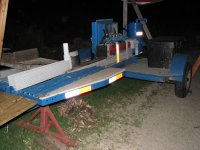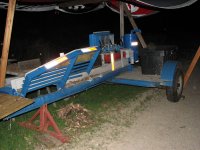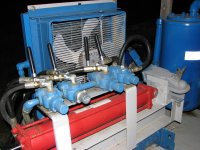I have a log splitter, or at least parts of one that I want to fix up. My plan was to run it off the tractor hydraulics - about 8 GPM. I split about 5 cords a year and figured it wouldn't be that much time on the tractor.
The existing push plate is 1/2" plate and pretty bent up. And the guide for the beam is lousy and allows the whole assembly to twist. I figure I should just redo the whole push plate assembly.
One question is how thick should I make the push plate, the plate that runs on the I beam, and the strips that go below the I beam flange to keep the slider on the beam? I figured I would put braces near each side that will help strengthen it.
Was also looking at how the fixed end of the cylinder is currently attached. 4 bolts in shear between the cylinder bracket and beam. Think they are 1/2". Seemed a bit small to me but I could be wrong.
It has a 5" cylinder that needs rebuilding. I may do that or get a 4" cylinder.
I found a good deal on a 4" x 24" but the rod is only 1.5". Had figured on using 2" rod. Is 1.5" big enough? How careful will I have to be not to bend it?
Thanks,
Jim
The existing push plate is 1/2" plate and pretty bent up. And the guide for the beam is lousy and allows the whole assembly to twist. I figure I should just redo the whole push plate assembly.
One question is how thick should I make the push plate, the plate that runs on the I beam, and the strips that go below the I beam flange to keep the slider on the beam? I figured I would put braces near each side that will help strengthen it.
Was also looking at how the fixed end of the cylinder is currently attached. 4 bolts in shear between the cylinder bracket and beam. Think they are 1/2". Seemed a bit small to me but I could be wrong.
It has a 5" cylinder that needs rebuilding. I may do that or get a 4" cylinder.
I found a good deal on a 4" x 24" but the rod is only 1.5". Had figured on using 2" rod. Is 1.5" big enough? How careful will I have to be not to bend it?
Thanks,
Jim



